No Strings Attached
Jane Ohland Cameron’s colourful Muppet-like puppets set loose the creative imagination of kids and adults with developmental disabilities.
The upstairs room at Community Living Dufferin was creative chaos. Just inside the door, a table vibrated with colours and shapes: wigs of bright yarn, blue and pink eyebrows and eyelashes, a display of little round noses in various hues. All makings for the puppets on the next table. On the racks beside them was a wardrobe of toddler-sized dresses and jackets, vests and shirts, as busy as the imagination. Adding a layer to the hubbub were the voices of people having fun. Only 10 people were in the room, but the volume of talk and laughter sounded like more.
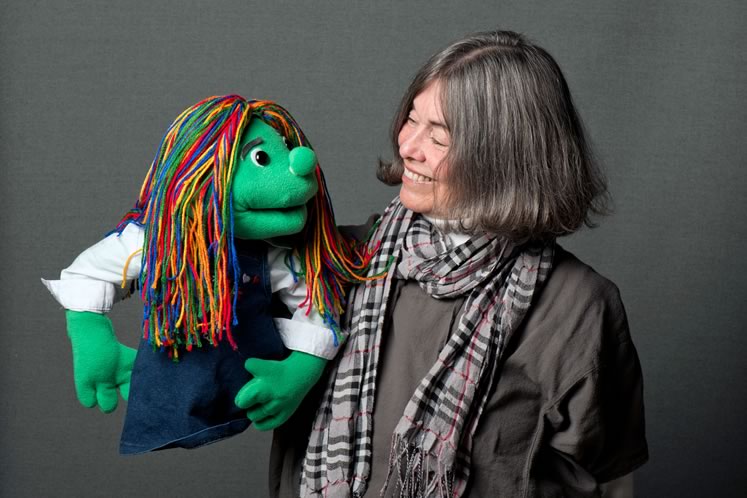
Puppet maker Jane Ohland Cameron and one of her fuzzy friends. Photos by Pete Paterson.
That get-together was in early October, the third weekly session of Pioneering with Puppets, a program that playwright and director Jane Ohland Cameron has brought to Community Living Dufferin, an organization that supports children and adults with developmental disabilities.
The idea of creating puppets and developing plays they could perform was a hit from the start. “We thought the people we support would really enjoy it,” says Carly Reid, a direct support professional at CLD. “The idea was appealing because we have so many people at CLD who have been involved in different theatrical programs … and this was such a different way of exploring, creating and performing. People get to create a character down to the smallest details, and they’re learning how to use puppets.”
Jane and Carly had already worked together for several years at Creative Partners on Stage, a partnership between CLD and Theatre Orangeville. Every year since 2008, the program has brought troupes of CLD actors to the Opera House stage in Orangeville. Jane and Carly, as well as choreographer Jenee Gowing and other professionals, created and rehearsed the plays the actors performed to the delight of live audiences. During that time, Jane put a different spin on the creative process, and she has continued her method with the puppeteers.
A theatre performance usually begins with the script, then actors perform the work as written. Jane turned that approach on its head, encouraging the story to grow from the performers’ imaginations and personal stories.
“I am working with a cast of the most spirited individuals who all have their own unique personalities, and there isn’t a sense of conformity,” she says. “We are expressing who we are as human beings. There’s an honesty in the work and an honesty in the process that I really appreciate. It’s just a really genuine sharing of a creative vision.”
The idea for the puppet workshop came to Jane after she went through boxes stored in her basement. Her sister Karen Ohland was a master puppet builder. In fact, more than 30 years ago, the Jim Henson Company was looking in Canada to find puppet builders to train. Company cofounder Jim Henson, the multi-talented American puppeteer and actor, was the mastermind behind Sesame Street, Fraggle Rock and other Muppet TV shows and movies.
Karen’s art portfolio earned her a spot as one of only two Canadians invited to the New York City workshop – she called it “Muppet U” – and after the workshop, she was invited to join the Henson team. That was in 1990, just before Henson unexpectedly died. Though Karen lost her opportunity, she stayed with puppetry, joining a Canadian company, Radical Sheep Productions, which produces award-winning children’s television programs, including The Big Comfy Couch. But then, in 2002, Karen suffered a stroke and died.
“Her death was a powerful loss for the Canadian puppet community,” says Jane, “and of course, for me as well. Karen and I had started in theatre together, and we would often sit on the phone, have a glass of wine and talk building materials. I would be working on props for a production or building something for my kids, and we would have these discussions about the different materials you could use and how you would approach it … the kind of conversation that would boggle most people’s minds, but we found it really stimulating.”
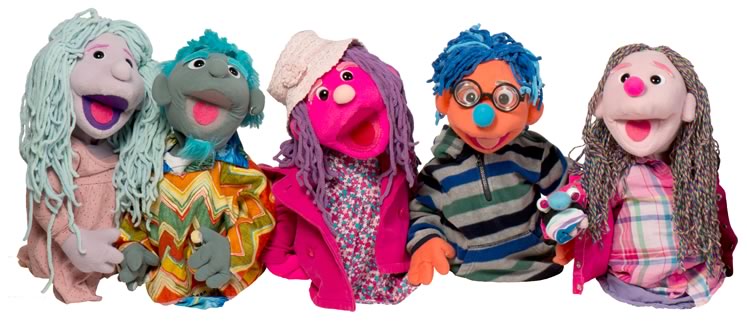
Jane and her sister Kris cleared out Karen’s apartment, and Jane stored the files and boxes of works-in-progress in her basement, where they sat, rarely disturbed, for most of 20 years. But when Jane’s adult sons, who are videographers, video editors and performers, asked for her help with a project involving puppets, she dived into her sister’s archive. Then the pandemic hit, and she figured she would have a few weeks to investigate more thoroughly. With the pandemic and lockdowns lasting much longer than anyone expected, Jane’s exploration of puppetry has flourished.
The workshop in Jane’s home is the source of the creative chaos that echoed in that upstairs room at CLD. The light from large windows sets all the colours aflame and illuminates the various shapes and pieces of puppets. And there are machines: a serger to make seams, a regular sewing machine, an industrial sewing machine, a photocopier, a computer, and a Cricut, a die-cutting machine that Jane uses to create templates.
Karen’s files included complete templates for puppets, but Jane’s puppets are not the same. Karen was a professional, making puppets for professionals, so her materials and construction methods were quite different. “I’m building puppets for people of all abilities,” says Jane, “and understanding that calls for changes in the way they are made.”
Muppets are constructed of reticulated foam and Antron fleece, but Jane’s puppets are made with half-inch craft foam and ordinary fleece, materials that are more readily available and less expensive. The primary reason for design changes, however, is to accommodate the needs of the individual puppeteers.
For one thing, Jane inserts a zipper in the back of the puppet’s head for easier access. Though some of the CLD puppeteers can rest an elbow on a table and hold their wrist at 90 degrees to work the mouth, others find it more comfortable to put their hand straight in through the back of the head and rest their arm on a box without having to hold their wrist at an angle.
Jane makes other changes to accommodate various needs and encourage creative flexibility. “I intentionally made the body and the arms separate so people could change it up. You might want a red head and a green body. You might want to bring in a different colour.”
Her strategy also makes it easier to change a puppet’s wardrobe, and there are lots of items to choose from. The puppets are the size of a toddler – one to two years old – because that’s when ready-made wardrobe choices expand. Younger babies are dressed mainly in onesies or sleepers, but the larger size provides a treasure trove of possibilities. “I frequent thrift shops and that has given us a phenomenal wardrobe: dresses, jean jackets, Calvin Klein, Joe Fresh, the Gap … adult-style clothing, but in miniature, and probably only worn once or twice,” says Jane.
The wardrobe continues to expand in different directions. “We are going to build animal puppets and will be looking for faux fur, and I’m always on the lookout for yarn for hairpieces,” she says. “Baby clothes between six months and two years would be so welcome, to add to the wardrobe department for the company of puppets at CLD.”
Though each puppet’s character begins with the costume, this is merely the first step in a process. “You do hairstyles, staging, character creation, scriptwriting, scene making and performance,” says Jane. “Essentially, we are moving through all aspects of play making, but it’s all taking place on a tabletop.”
In her home workshop, Jane invites me to put a puppet blank on my hand. The blank had black eyes but no other features. She takes two small round pieces of white felt and sets these whites behind the eyes. She adds eyebrows and suddenly the puppet has an expression on its face. A nose and a wig give it more personality. It looks as if it has something to say – just like the CLD puppeteers’ creations, which have unique personalities and a great deal to say (see below).
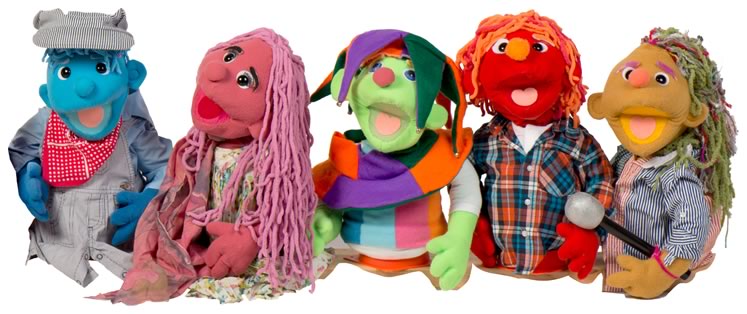
As Pioneering with Puppets continues, the characters will come together in a story. So far, some musicians and their friends are on the Peace Train in 1969, heading to Toronto for a rock concert. There will be a turning point somewhere along the line, and someone will have to come to the rescue. Who knows what will happen by the end of the tale? But no matter how things turn out, the troupe will create a video to tell the story.
The puppets have already held a couple of celebrations: a birthday party for three of the puppeteers and a Halloween party. But those were just the start. Jane is buzzing with ideas. “We can do fairy tales, medieval costuming, historical things. We can do videos with a message. It’s really, really quite unlimited.”
Puppets can also help overcome shyness the performer may feel. “I have a feeling that some actors may express themselves more easily this way,” says Jane. “It’s like wearing a mask. The puppet neutralizes the performer and switches the focus to the puppet.”
At Community Living Dufferin, Jane sees ability and challenges, not disability. Working with the support workers, whose creativity and exceptional problem-solving ability she praises, she looks for ways to work with a challenge – or around it. “You want to accommodate the actors in such a way that you simply skirt the challenges and bring out the very best in every individual.”
Initially, Pioneering with Puppets was to be a four-week pilot project, but success has extended its run. This year’s program will continue into the holiday season, and another program is in the works for 2022.
For the entire troupe the project has provided a sense of delight and fulfilment that goes well beyond simply getting together to build puppets. “The joy and laughter that occurs during this program,” says Carly. “The endless smiles, conversations, questions and inclusion. The team atmosphere. The happiness that participants exude while walking out after another experience is remarkable. That is the true success.”
The Puppet Pioneers
By the third week of the Pioneering with Puppets program at Community Living Dufferin, development of the puppets’ characters was well underway. Although their personas may evolve and expand as the workshops continue, here’s who they are so far.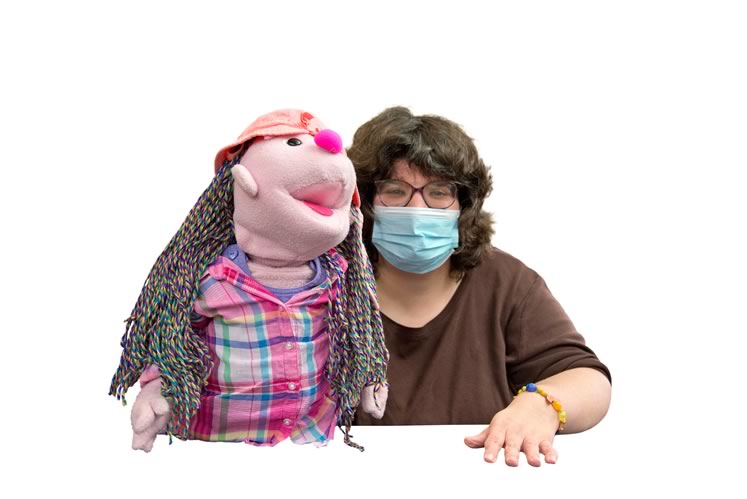
Sarah Godfrey’s puppet, Miss Puppet, is pink and purple, her favourite colours. Miss Puppet is 15 years old, in Grade 10, and loves two subjects: art and life sciences. She also likes lunch. Pinky’s favourite part of life sciences is making treats.
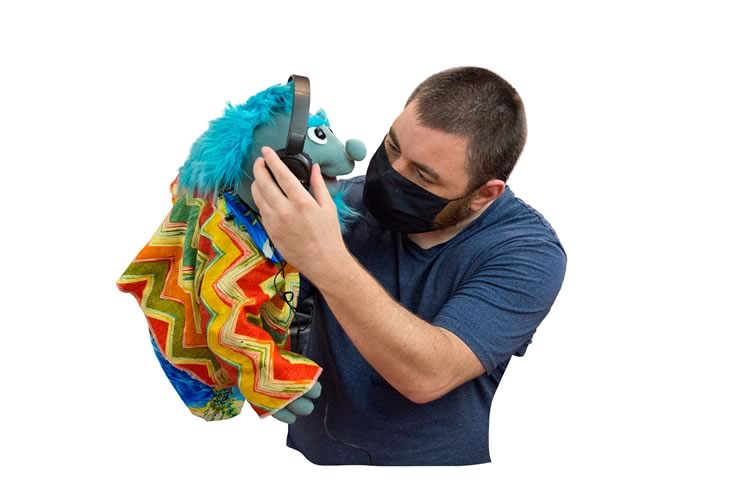
Allan Boers’ passion is all about popular music with an emphasis on country. He talks about Johnny Cash, Bo Diddley, George Strait, Elton John, Simon and Garfunkel, the Beatles and more. Allan’s puppet, Jimi, has a hippie vibe with a bright turquoise goatee and hair. He plays guitar and drums.
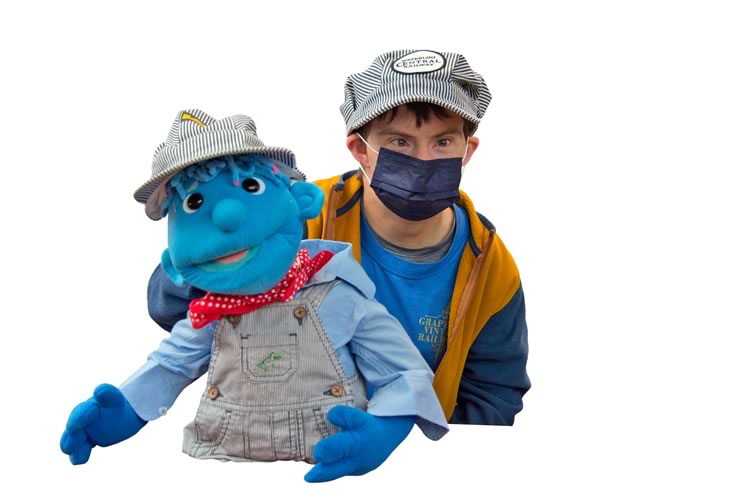
Chris Dawe is fascinated by trains, particularly steam engines, and talks about going with his dad to see trains in Waterloo and Tottenham. His puppet, named Christopher, is a train conductor, dressed in blue-and-white striped overalls with a matching peaked hat.
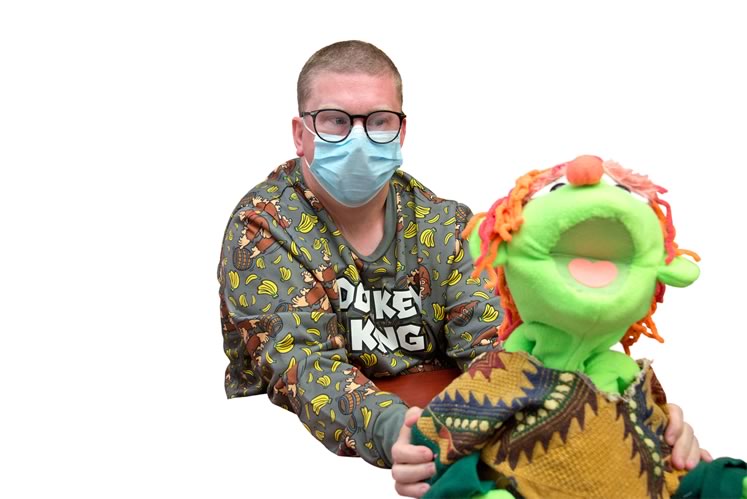
Jeremy Huntley knows the history and continuing story of the Muppets. His puppet started as Li’l Jerry, inspired by the lead singer of the Muppet group Little Jerry and the Monotones, and was bright green with a pink nose and orange-red hair. Since then, Jeremy’s puppet has evolved into a court jester named Curt Jester.
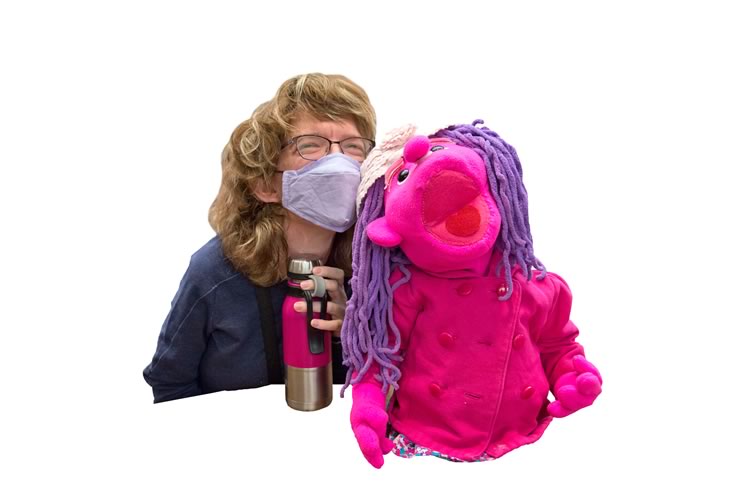
Kassondra Staveley’s puppet, Pinky, reflects Kassondra’s interests and favourite colours. Pinky likes pink and purple, and loves to eat pasta. She’s in high school and enjoys watching TV and listening to music. Her favourite singer is Shania Twain and her favourite song is “Party for Two.”
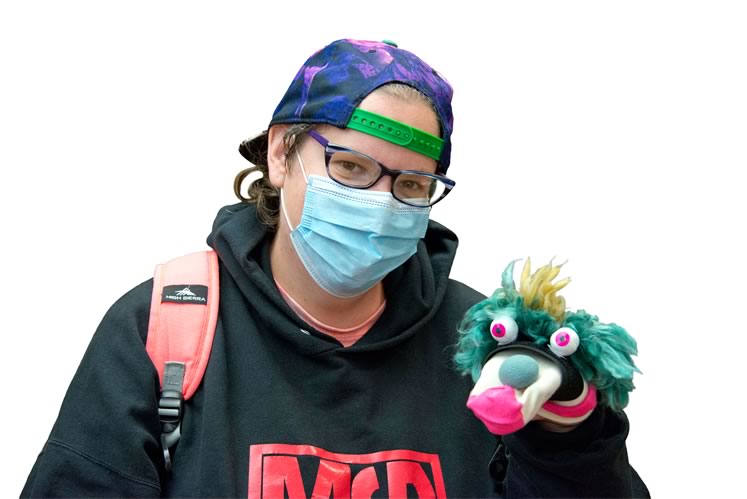
Katie Reid’s puppet, Fiery Magic, is an artist from another planet. Her world was destroyed, but she escaped and came to Earth. Now she wants to blend in, so no one knows she’s an alien. She wears a vest with an embroidered kitten and has paint brushes stuck in her hair. Fiery Magic has a magic power – things she paints become real.
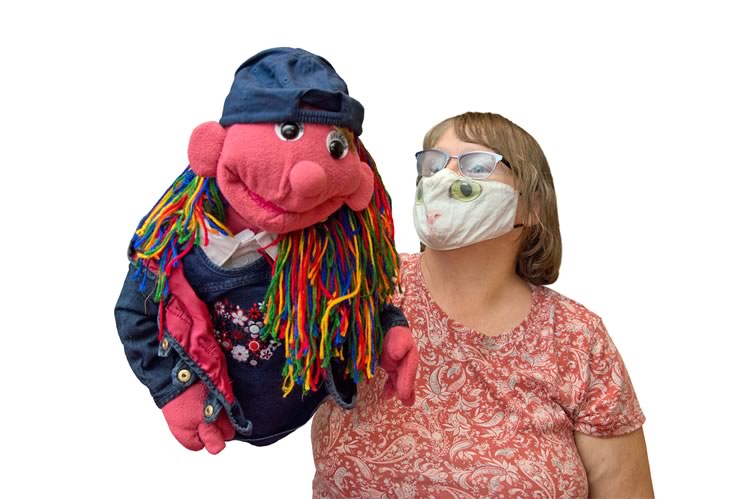 Barb Squirrell takes inspiration from her mother’s favourite actress from the 1950s. Her puppet is Loretta Forever Young. Loretta is 18 and going to high school. She wants to be a glamorous movie star, so she’s studying dance, drama and singing.
Barb Squirrell takes inspiration from her mother’s favourite actress from the 1950s. Her puppet is Loretta Forever Young. Loretta is 18 and going to high school. She wants to be a glamorous movie star, so she’s studying dance, drama and singing.











You are such an inspiration
Tara Wilson from Caledon on Jan 9, 2022 at 6:05 am |
Jane, you are an amazing inspiration to us all. It is obvious that this is your passion and to share it with people is wonderful. You have found your niche in life and make these puppets come to life. You are a great lady, keep up the good
work AND hopefully next Summer you will drive to our home and we will have a wonderful visit. Your bed is waiting for you!!!! Love Carolyn
Carolyn Russell from Sarnia, Ontario on Dec 17, 2021 at 6:23 pm |
A wonderful collaboration of our amazing community. Thank you In The Hills, Jane, Community Living Dufferin, puppeteers, story makers and all involved. So fortunate to know many of this team! A feel-good article.
Susan Reynolds on Dec 10, 2021 at 11:17 am |
An amazing convergence of talents at CPOS! Puppets’ personalities will be exciting and unique, just like their puppeteers’. I am looking forward to seeing them all on stage. All the best!
Cathy Whitcombe from Orangeville on Dec 6, 2021 at 2:20 pm |
The generous spirit of Jim Henson and Karen Ohland was too vibrant to be interred in 1990, thank you Jane Ohland Cameron and Community Living Dufferin for this most appropriate resurrection (and kudos to Tony Reynolds for exquisite research and writing)
Steven Hargraves from n6h 3l4 on Dec 4, 2021 at 8:14 am |
This is a a tribute to creativity, kindness and inclusiveness! Brilliant! This is what the world needs more of!!! Looking forward to attending the performances. Wishing everyone continued success. Warmest regards, Jeanette Brox
Jeanette Brox from Toronto on Dec 3, 2021 at 2:55 pm |